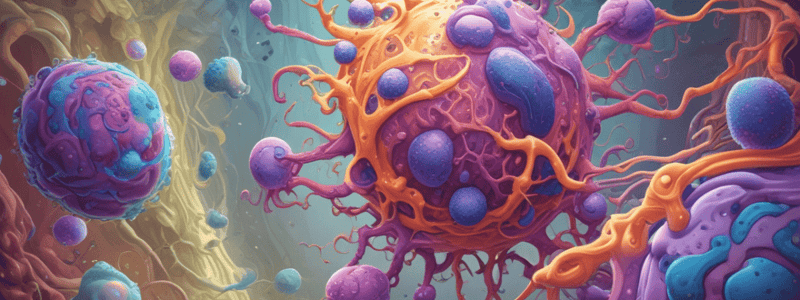Podcast
Questions and Answers
What is the first phase of phagocytosis?
What is the first phase of phagocytosis?
- Digestion
- Adherence
- Chemotaxis (correct)
- Ingestion
Which phase involves the phagocyte merging with a lysosome?
Which phase involves the phagocyte merging with a lysosome?
- Ingestion
- Adherence
- Killing
- Digestion (correct)
What type of cell releases histamine during inflammation?
What type of cell releases histamine during inflammation?
- Neutrophils
- Macrophages
- Mast cells (correct)
- Red blood cells
Which of the following mediators causes vasodilation and increased vascular permeability?
Which of the following mediators causes vasodilation and increased vascular permeability?
Which inflammation symptom is characterized by heat?
Which inflammation symptom is characterized by heat?
What occurs during the adherence phase of phagocytosis?
What occurs during the adherence phase of phagocytosis?
What is pus primarily composed of?
What is pus primarily composed of?
What is the role of C3b in complement activation?
What is the role of C3b in complement activation?
Which type of immunity is characterized by its non-specific nature?
Which type of immunity is characterized by its non-specific nature?
What is the role of epithelial tight junctions in the respiratory tract?
What is the role of epithelial tight junctions in the respiratory tract?
Which of the following is NOT an external innate immune defense?
Which of the following is NOT an external innate immune defense?
What is the primary function of interferons in the immune system?
What is the primary function of interferons in the immune system?
Which type of cell produces mucus in the respiratory tract?
Which type of cell produces mucus in the respiratory tract?
What is the function of natural killer (NK) cells in the immune system?
What is the function of natural killer (NK) cells in the immune system?
How fast can a bacterial population double under optimal conditions every 20 minutes?
How fast can a bacterial population double under optimal conditions every 20 minutes?
Which antimicrobial substance is produced in sweat?
Which antimicrobial substance is produced in sweat?
Flashcards are hidden until you start studying
Study Notes
Phagocytosis
- Phagocytosis is a process involving neutrophils and macrophages to engulf and destroy foreign substances and microbes.
- Phagocytosis involves five phases: chemotaxis, adherence, ingestion, digestion, and killing.
- Chemotaxis: microbe attracts phagocytes towards itself.
- Adherence: phagocyte attaches to the microbe.
- Ingestion: phagocyte engulfs the microbe, forming a phagosome.
- Digestion: the phagosome merges with a lysosome, releasing enzymes and breaking down the microbe.
- Killing: the microbe is destroyed.
Wound Repair in the Skin
- Damaged tissue releases chemical signals that attract macrophages.
- Macrophages release chemical signals that initiate blood clotting.
- A new blood clot forms, and phagocytosis occurs.
- The wound is eventually repaired.
Mediators of Vasodilation and Increased Vascular Permeability
- Histamine: released from mast cells activated by complement proteins (C3a and C5a).
- Bradykinin: a vasoactive peptide.
- Prostaglandins: also affect nerve endings and cause pain.
- Leukotrienes (LTC4): induce vasodilation and increased vascular permeability.
Inflammation
- The stages of inflammation include vasodilation, increased vascular permeability, phagocyte emigration, and tissue repair.
- The symptoms of inflammation are rubor (redness), calor (heat), tumor (swelling), and dolor (pain).
- Phagocyte migration involves the movement of phagocytes from the blood to the site of tissue injury.
Pus
- Macrophages engulf bacteria, damaged tissue, and worn out neutrophils, eventually leading to the formation of pus.
- Pus is a pocket of dead phagocytes and damaged tissue that occurs at most sites of inflammation and persists until the bacteria is cleared.
- Pus can drain externally or internally, for example in patients with massive lung infection.
Complement Activation
- Complement activation enhances phagocytosis by coating with C3b (opsonisation).
- Complement activation increases blood vessel permeability and chemotactic attraction of phagocytes.
Immunology
- The immune system can be divided into two categories: innate immunity and adaptive immunity.
- Innate immunity is a natural immune response that prevents or limits infection and is non-specific.
- Adaptive immunity is an acquired response that eradicates infection and is highly specific.
Infection
- Bacteria can be as small as 1.8 µm in diameter and 7 µm long.
- Viruses can be as small as 20-300 nm.
- Parasites can range from 15-35 cm (Ascaris) to 30 m (Tapeworm).
Mucus Membranes in the Respiratory Tract and Gut
- Epithelial tight junctions prevent infection.
- Mucus is produced by goblet cells in the epithelium and by mucus glands in the lower respiratory tract.
- Cilia in the lower respiratory tract move the mucus up toward the larynx.
- Epithelial cells produce antimicrobial peptides (defensins) and lysozyme.
Internal Innate Immune Defences
- Interferons: antiviral proteins that inhibit replication of viruses in cells nearby, and limit the spread of the virus.
- Complement proteins: when activated promote bacterial cytolysis, phagocytosis, and inflammation.
- Iron binding proteins: inhibit the growth of iron-dependent bacteria.
- Antimicrobial peptides (AMPs): such as dermicidin in sweat, defensins produced by epithelial cells, neutrophils, and macrophages.
External Defenses
- The skin provides a physical barrier to infection.
- Antimicrobial fatty acids in sebum from sebaceous glands.
- Extracellular antimicrobial lipids; ceramide and sphingosine.
- Acid pH of sweat (lactic acid).
- Antimicrobial peptides eg dermicidin in sweat from eccrine glands.
- The flow of tears, urine, saliva, perspiration, vaginal secretions, to prevent microbe adhesion to epithelial surfaces.
- Lysozyme (muramidase) in tears, saliva, and mucus.
- Defecation (diarrhea) and vomiting to expel microbes.
- Highly acidic gastric acid secretions (pH 1.2-3.0) destroy bacteria and toxins.
Studying That Suits You
Use AI to generate personalized quizzes and flashcards to suit your learning preferences.



